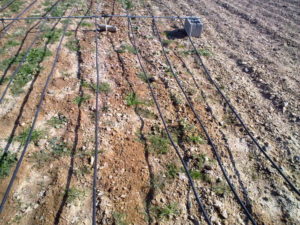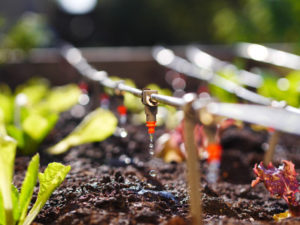Huge areas of arable land have been salinated in recent decades. In other words, de facto it has become unusable for agriculture because crops can hardly grow on such soils. There are several sources, but between 5,000 and 10,000 acres of arable land are lost per day worldwide.
If irrigated with the old methods, i.e. with a lot of water and a lot of scattering loss, the evaporation is very high, especially in very warm regions of this world. What remains are the salts, which cannot evaporate with. These oversalt the soil. If there is a shortage of well water, drilling deeper and deeper is necessary. As a result, more and more minerals and salts are being added to the extracted water. The problem’s escalating everywhere around the world. Once the salinity of the soil reaches a certain level, the land can not be used for agriculture anymore.


The first field we have rehabilitated
One of our partners near Esfahan has come into contact with a farmer who was desperate. His fields had become totally white in some places and therefore unusable. Because also his water pipe was calcified he got a ring for testing.
After a few weeks the same farmer came into the office beaming with joy, and reported that all the salt in the fields had disappeared by itself. This news has been circulating. Shortly thereafter, the University mediatized and declared it wanted to make a scientific study on this subject. Since this problem affects the entire region, it rains significantly less in the area from Syria to Pakistan, than it did ten years ago.
The result of the study is clearly positive
For the field trial, one field was irrigated half with untreated water and half with water treated by Merus. Then these two fields were compared with each other.
First the condition of the irrigation, especially the nozzles. The result was very convincing. See drip irrigation for details.
The second and, in our opinion, more important result, while the untreated field showed the first signs of salination, was that the field treated by Merus showed almost nothing of salt.
One of the effects of Merus is to significantly increase the solubility of salts in water. This effect results in less deposits forming on the soils. And that if the water still has free capacity to bind salts, then the existing salt is dissolved and taken along with the water. The mechanisms of action are the same as in technical applications, where pipes and systems remain free of deposits.
This study has been published by the ASCE, the American Society of Civil Engineers. We are not allowed to show this study here, as the rights to it lie with the ASCE.
If you are interested, just click here and search for ‚Merus Ring‘ on the ASCE Library page using the search function. This article is only available in English.
The Merus Ring holds the salt in the water and takes it with it to greater depths
Where the limits of this method lie we cannot say today yet. So neither up to how much TDS in the water we can achieve these results, nor up to what evaporation rate. However, we know from technical applications that several conditions must always be taken into account in order to be able to make such statements.
In another study, the university staff wanted to find out at what depths the salt in the water reaches, or at what depths the salination of the soil takes place. However, this study has not yet been carried out due to a lack of funds.
